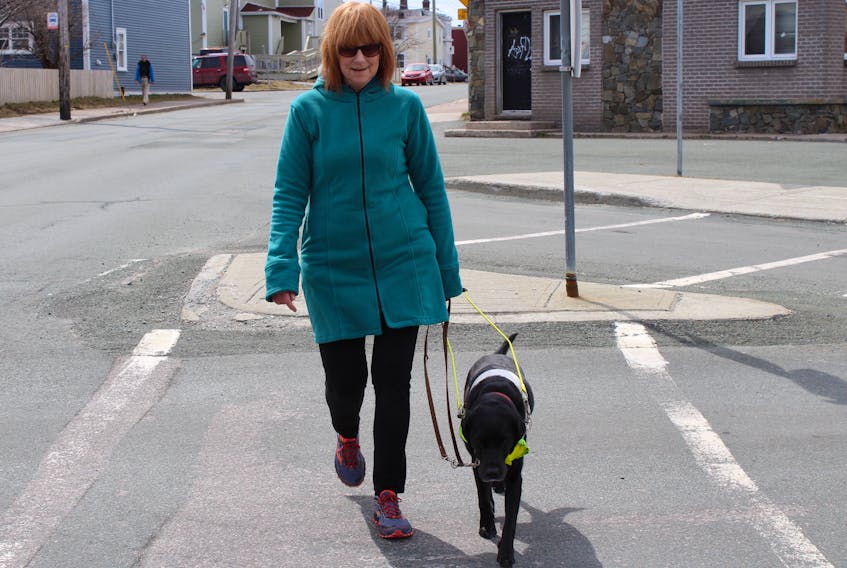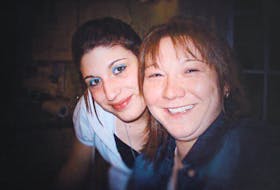The look on Anne Malone’s face tells the story.
Ask her about the impact her guide dog, Cheryl, has had on her life and she lights up.
Malone, who lives in St. John’s, is known to many from her years as a proposal writer for the arts community.
She lost most of her eyesight in 2006 through macular degeneration, something she’d struggled with her entire life. She was born extremely nearsighted, but didn’t dwell on it as a child. She thought it was normal not to see the blackboard well — which is the reason, she says, why she did poorly in math but excelled at language and history.
At around age 19 she started to notice that her vision was deteriorating.
“It slowly advanced until 2005,” she says.
Malone was in the middle of a project at work when she had a bizarre experience.
“I was co-ordinating a large craft show, a national event in a stadium. On Monday, everything was fine. On Tuesday, I awoke and could not see.”
At first she thought it was just a fogged-up bathroom mirror, or she needed to clean her lenses — but to no avail.
She’d had a small retinal hemorrhage in the transparent membrane on her eyeball on the macula, near the centre of the retina, which created the vision impairment.
She had to explain to her boss that although she looked the same physically and appeared to be herself, there was something dreadfully wrong.
It was a life-altering experience to lose her vision, but then another life-changing thing came her way.
“Cheryl has improved everything in my life,” she said of the dog. “It is life-changing.”
Malone said just going to an ATM made her feel anxious because of her blindness.
“I would feel vulnerable, and I was aware that a behaviour I have might exhibit that I was vulnerable and exploitable,” she added.
Once she and Cheryl became a team, that anxiety went away.
Being able to do simple things, like going for a walk, has helped Malone reacquaint herself with the city she grew up in.
She said St. John’s was challenging for her before she was paired with Cheryl because the acoustic qualities of the city made it difficult for her to go for a walk, to the grocery store or even to visit a friend.
“There is a lot of wind here, which was challenging. I could hear the cars in the distance, but I couldn’t judge the distance because of the wind.”
After a Google search in 2010, in an attempt to relieve her growing fears, she learned about guide dogs and applied for one.
In October 2012, she learned she’d been accepted and went off to a four-week training course where she learned how to handle the dog and got used to working with Cheryl.
Now, years later, they are living life and enjoying each other’s company.
“It was funny, one of the things they taught me was to think like a dog,” Malone said.
“I learned canine behaviour, mobility, and they taught us relationship and team-building.”
She said she and Cheryl have worked hard at becoming precise and effective.
April 25 is International Guide Dog Day, and Malone is more than happy to celebrate.
Guide dogs have figuratively and literally saved countless lives.
Thanks to Cheryl, Malone now has an active lifestyle again and she’s become an advocate for people with vision loss. She’s also an example of someone who has dealt with challenges head-on and has a positive attitude.
Guide dogs — fiction or fact?
Fiction: Any dog can be trained to become a guide dog.
Fact: Canadian Guide Dogs for the Blind breeds its own puppies based on temperament and health. Pups are raised with the purpose to become a guide dog. Only the puppies that have the right temperament, attitude and desire to do the work will complete the training program. No dog is ever forced to be a guide dog.
Fiction: It is OK to say hello to a guide dog.
Fact: Most people know that you do not pet a guide dog when it is working. However, it is also important not to say hello, and to ignore the dog completely if possible, so that it can focus on its work.
Fiction: Guide dogs do not get to play and enjoy their life.
Fact: Guide dogs love to work. It is pleasurable for the dog, and it spends every minute of the day with its master. However, dogs love to play, and guide dogs are no different. When the harness is off or when the dog is at home, it is not working and is a well-behaved pet, off-duty and ready to play or relax.
Fiction: Guide dogs know where to go and read signs.
Fact: Guide dogs will obey commands such as “find the stairs,” “find the bus,” or “left” and “right,” but they will lead only if instructed to do so. The guide dog user must familiarize him/herself with routes in advance. The dog will always navigate better in familiar environments.
Fiction: The government funds guide dogs.
Fact: Canadian Guide Dogs for the Blind operates solely through donations, as an independent registered Canadian charity. It trains guide dogs and provides them free of charge to their clients. Before applying for a guide dog, an applicant must have the necessary orientation and mobility skills required for enhanced mobility and the use of a guide dog. The person must also be ready to accept the responsibility of properly caring for a dog and be in a financial position to provide for food and veterinary expenses.
Fiction: Guide dogs wait for a green light.
Fact: Dogs are colour blind. A guide dog will lead its owner to a curb, then sit and await further instructions. The person must decide when it is safe to cross. A dog will block the path of the person if an error in judgment is made and there is oncoming traffic.
Fiction: Guide dogs are permitted access to public places if a business owner is community-minded.
Fact: Guide dogs are permitted access to all public places in Canada through various provincial legislation and the Canadian Human Rights Act. A person who is blind cannot be denied entry with a guide dog. It is against the law.
Fiction: Guide dogs are taken away from the handler when the dog retires.
Fact: Most guide dog handlers will keep the retiring guide dog as a family pet when it retires.
Fiction: Canadian Guide Dogs for the Blind is the CNIB (Canadian National Institute for the Blind).
Fact: Canadian Guide Dogs for the Blind and CNIB are not affiliated and are two separate organizations. Canadian Guide Dogs for the Blind was founded in 1984 and has trained 843 working guide dog teams across Canada. To learn more about guide dogs in Canada, visit guidedogs.ca.









